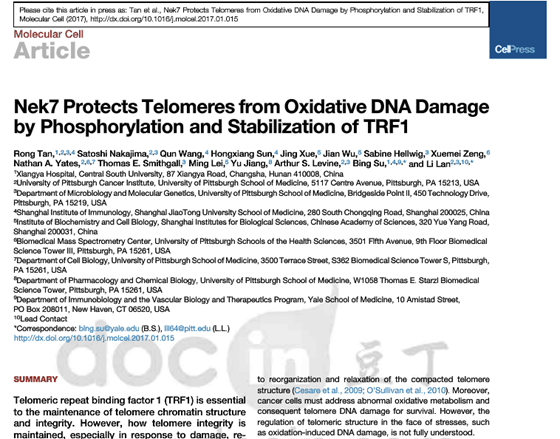Molecular Cell (online version), a companion to Cell which is the leading journal of biochemistry and biology, published the latest research paper of the research team led by Su Bin from Central South University, a chair professor included in Changjiang Scholars Program. The paper is titled Nek7 Protects Telomeres from Oxidative DNA Damage by Phosphorylation and Stabilization of TRF1(IF=13.958) and finished by Xiangya Hospital as the first unit. The authors are the graduate students from Professor Su Bin’s laboratory and Dr. Tan Rong from Xiangya Hospital Central South University, while Professor Su Bin and Professor Li Lan from the School of Medicine of University of Pittsburgh are the co-corresponding authors. The members participating in this study also include Arthur S. Levine, Dean of the School of Medicine of University of Pittsburgh in close cooperation with Xiangya Hospital, Lei Ming, Director of the National Southern Center of Protein Research of Chinese Academy of Sciences, as well as the members from Shanghai Jiaotong University. Professor Su’s research team is committed to studying signaling pathways of cancer cell molecules. This is another great effort that this research team has made in basic research, and is supported by National Natural Science Foundation of China (NSFC) and National Institutes of Health (NIH) of the United States.

Directed by Professor Su Bin, Dr. Tan Rong cooperated with Professor Li Lan from the School of Medicine of University of Pittsburgh, and discovered a new telomere regulation mechanism. Telomeres are at the end of chromosomes, and crucial for maintaining the stability of genomes. In mammal cells, telomere repeat binding factors (TRFs) play an important role in localization of telomerase positive and negative cells and expression in cell cycles. However, how telomere end-binding protein (TEBP) keeps the integrity of telomeres, especially in response to damage, is a major scientific problem.
The new telomere regulation mechanism has solved that problem. With the help of a specific oxidative damage induction system of telomeres, Professor Su’s research team discovered Nek7, a member of the Never in Mitosis Gene A (NIMA) kinase family. Nek7 is recruited to damaged telomeres to stabilize TRF1. Nek7 deficiency leads to aberrant telomeres, excessively oxidized telomere DNAs and augmented cell death. Mechanistically, according to this study, Nek7 interacts with and phosphorylates TRF1 on Ser114, to prevent TRF1 from binding to Fbx4 (an Skp1-Cul1-F box E3 ligase subunit), thus alleviating proteasomal degradation of TRF1 and maintaining the stability of TRF1.
According to Professor Su’s research team, the expression and modification of TRF1 may be an important index for aging damage and cancer translation in the future, and cells with the highest expression level of TRF1 bear the highest pluripotency and are more resistant to oxidative damage. Meanwhile, the research team also explained how cells resist oxidative stress in continuous accumulation of oxidative metabolism and maintain its proliferation. The above research results give a big boost to the exploration of the telomere regulation mechanism, lay a foundation for elaborating the mechanisms of aging and aging-related diseases, and provide new therapy methods for such diseases.











